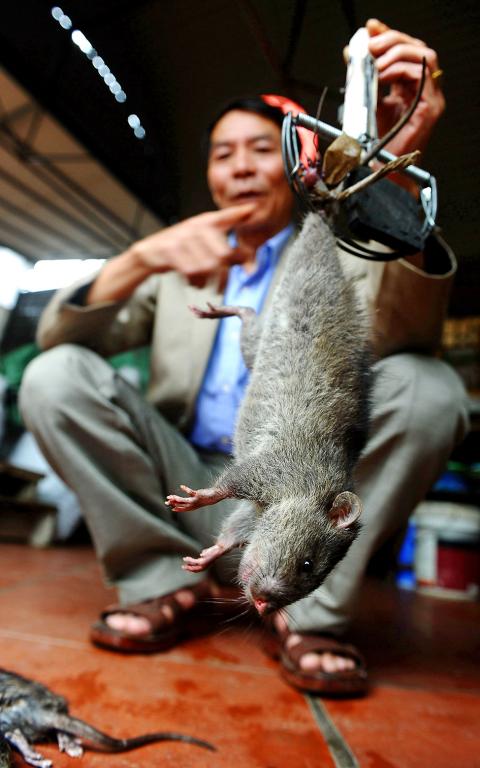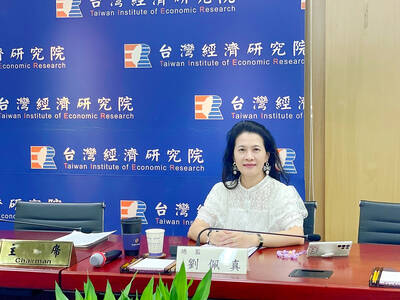Grinning widely, Tran Quang Thieu brandishes the day’s haul: 10kg of rats caught in rice paddies near Hanoi. A menace to Vietnam’s rice crop, the vermin are regularly trapped — and sometimes eaten.
In his village of Van Binh on the outskirts of Hanoi, Thieu and his team work night and day in the area’s rice paddies. They estimate that 20 percent of the annual grain crop is lost to hungry rats.
Rice is an essential part of the Vietnamese economy, which is the world’s second-largest exporter of the staple grain.

Photo: AFP
“We used to have to accept the loss of large chunks of our paddies — the rats destroyed it. It made us wonder why we bothered working so hard,” 46-year-old farmer Hoang Thi Tuyet said.
Rodents can be a determined enemy.
“It’s hard to trap them, they’re clever, they move fast and in Vietnam, there are 43 different species of rat to contend with,” Thieu said.
However, in 1998, Thieu had a breakthrough when he invented a new rat trap that was not only more effective than anything farmers had previously tried, it also works without bait, relying on extremely strong springs.
Thieu estimates that his traps and unique, rat-hunting methods have since killed millions of rats.
“The agricultural losses caused by rats are enormous, and these rodents can cause fires and explosions by chewing electric cables in houses and factories,” he said.
At least 500,000 hectares of rice paddy is lost to rats each year, out of about 7.5 million hectares planted across Vietnam, said Nguyen Manh Hung of the Institute of Agricultural Sciences.
“Rats cause hundreds of millions of dollars of damage, before we even mention the risk of communicable diseases,” he said.
So it is no surprise that Thieu — known as the “Rat King” for the trap that has made him a fortune — is an extremely busy man.
“We get requests to come and catch rats from all over the country, but we can’t take them all up, we just don’t have the time,” he said.
His five children have all joined the family business and between them now run six companies to trap rats. About 30 million of his traps have been sold and are used throughout Vietnam, as well as in China and Cambodia.
Thieu does not just sell them to rice farmers either, he has signed contracts to help hospitals, hotels, restaurants and schools exterminate the pests, and even the Hanoi police’s headquarters.
Over the past few years, the rat population has exploded in Vietnam due to a decline in the population of their natural predators: snakes and cats. Serpents and felines are popular delicacies and their widespread consumption — thanks in part to an increasingly affluent middle class — has allowed the rat population to grow unchecked.
For this reason, many local authorities are encouraging people to kill rats. In Thai Binh, authorities are offering farmers cash for rat tails as a means of encouraging them to kill the pests in a simple intervention that protects rice crops without using chemicals.
In addition, rat hunters can sell their bounty to restaurants. Paddy rats are widely consumed in the country and some of the ones captured by Thieu in his traps are sent to restaurants. Others are given to the farmers whose fields they are caught in, who either eat them or use them to feed their pigs or fish.
“For a long time we’ve eaten rat in Vietnam. Especially since the war, that was when people — mostly farmers — started eating them for want of other meat,” Thieu said.
Grain-fed paddy rats are a healthier animal than their city cousins and are prepared in a variety of ways nationwide, being often grilled or steamed with lemongrass.
“Rat meat is very oily, like suckling pig, and very rich in protein,” Do Van Phong said as he sat in a Hanoi restaurant with two large paddy rats on his plate.

IN THE AIR: While most companies said they were committed to North American operations, some added that production and costs would depend on the outcome of a US trade probe Leading local contract electronics makers Wistron Corp (緯創), Quanta Computer Inc (廣達), Inventec Corp (英業達) and Compal Electronics Inc (仁寶) are to maintain their North American expansion plans, despite Washington’s 20 percent tariff on Taiwanese goods. Wistron said it has long maintained a presence in the US, while distributing production across Taiwan, North America, Southeast Asia and Europe. The company is in talks with customers to align capacity with their site preferences, a company official told the Taipei Times by telephone on Friday. The company is still in talks with clients over who would bear the tariff costs, with the outcome pending further

NEGOTIATIONS: Semiconductors play an outsized role in Taiwan’s industrial and economic development and are a major driver of the Taiwan-US trade imbalance With US President Donald Trump threatening to impose tariffs on semiconductors, Taiwan is expected to face a significant challenge, as information and communications technology (ICT) products account for more than 70 percent of its exports to the US, Chung-Hua Institution for Economic Research (CIER, 中華經濟研究院) president Lien Hsien-ming (連賢明) said on Friday. Compared with other countries, semiconductors play a disproportionately large role in Taiwan’s industrial and economic development, Lien said. As the sixth-largest contributor to the US trade deficit, Taiwan recorded a US$73.9 billion trade surplus with the US last year — up from US$47.8 billion in 2023 — driven by strong

A proposed 100 percent tariff on chip imports announced by US President Donald Trump could shift more of Taiwan’s semiconductor production overseas, a Taiwan Institute of Economic Research (TIER) researcher said yesterday. Trump’s tariff policy will accelerate the global semiconductor industry’s pace to establish roots in the US, leading to higher supply chain costs and ultimately raising prices of consumer electronics and creating uncertainty for future market demand, Arisa Liu (劉佩真) at the institute’s Taiwan Industry Economics Database said in a telephone interview. Trump’s move signals his intention to "restore the glory of the US semiconductor industry," Liu noted, saying that

AI: Softbank’s stake increases in Nvidia and TSMC reflect Masayoshi Son’s effort to gain a foothold in key nodes of the AI value chain, from chip design to data infrastructure Softbank Group Corp is building up stakes in Nvidia Corp and Taiwan Semiconductor Manufacturing Co (TSMC, 台積電), the latest reflection of founder Masayoshi Son’s focus on the tools and hardware underpinning artificial intelligence (AI). The Japanese technology investor raised its stake in Nvidia to about US$3 billion by the end of March, up from US$1 billion in the prior quarter, regulatory filings showed. It bought about US$330 million worth of TSMC shares and US$170 million in Oracle Corp, they showed. Softbank’s signature Vision Fund has also monetized almost US$2 billion of public and private assets in the first half of this year,